Yule/Winter Solstice
We have entered the dark time, the womb of the mother. At the Winter Solstice we reach the depth of that darkness with the longest night of the year. Darkness has reached its peak. It is a time for composting and transmuting what no longer serves us. For Process Pagans, we look to our stories, myths, chants, and traditions to remind us that the wheel of the year is not a circle but rather a spiral. Each yule brings with it new possibilities. We reflect of what has been, as that has been prehended, but then we look forward to the solstice and the birth of the sun. Each night, thereafter, will be a little shorter and we are lured toward spring.
~ Kathleen Reeves
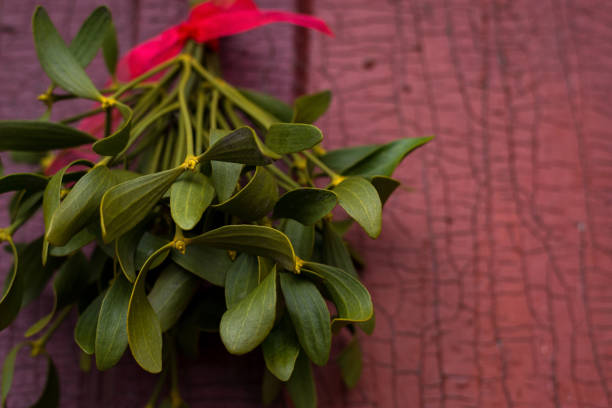
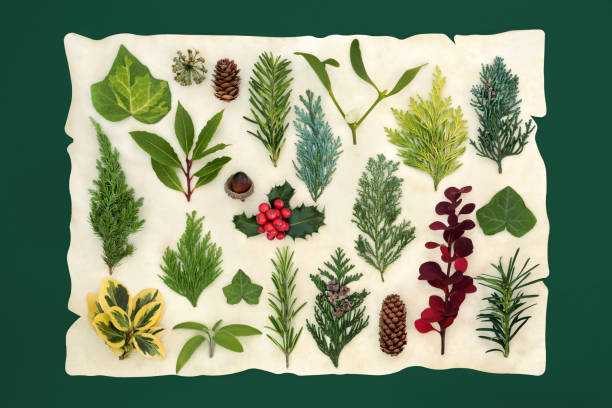
“Yule is when the dark half of the year cedes to the light half. Known as Solstice Night, Awaiting the rebirth of the Sun God. Bonfires, wassailing crops with toasts of spiced cider a time of madness and awesomeness” ~ Anujj Elviis
Colloquy of the Oak and Holly King
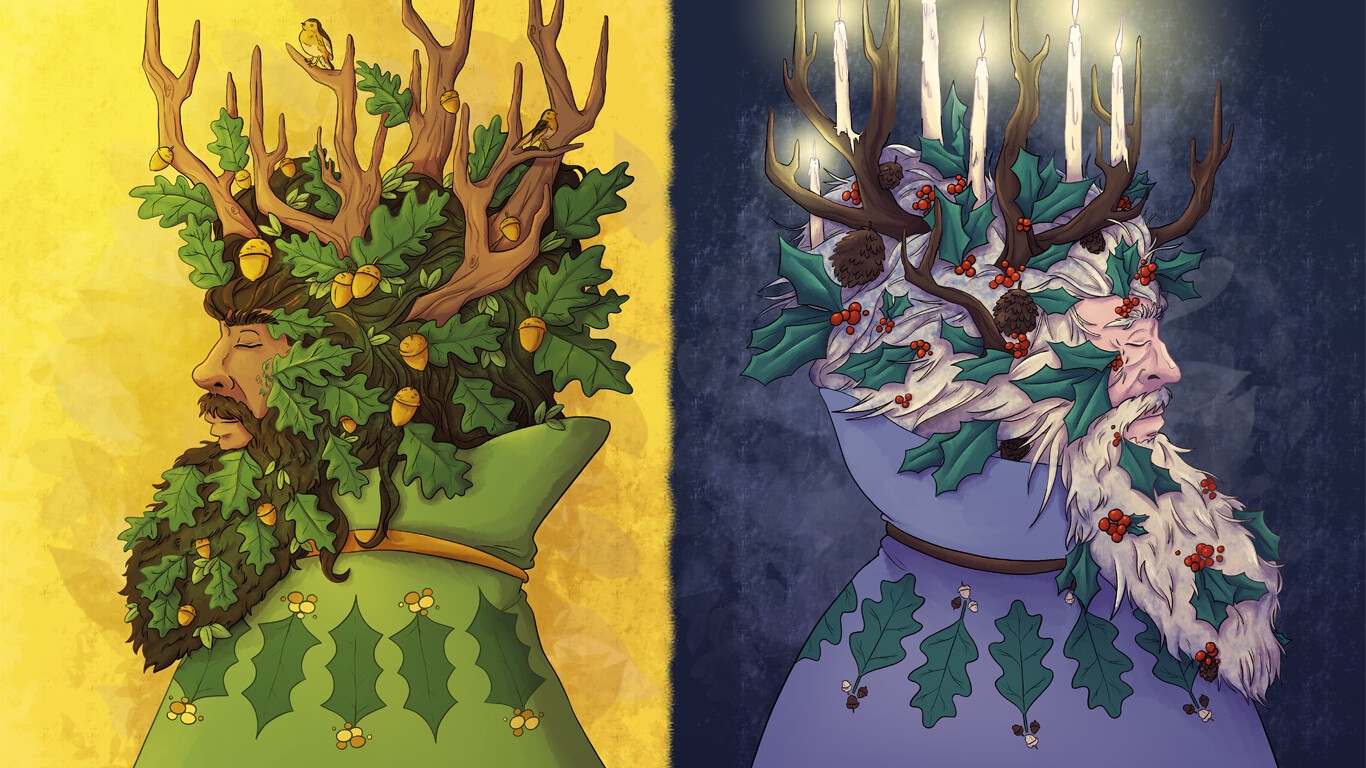
For It is said at the time of the solstices, two great kings do battle, The Oak king who rules the waxing year and the Holly King who who rules the waning year. This is not a battle of hate, but rather is a battle of light and reflects the arc of the sun as it makes its journey across our skies. Some say that the battle is won and lost by the power of the sword, but here, the Oak and Holly King enter a colloquy, an ancient bardic battle of words and wit to win the crown, and the light of the land.
Cold and bright the solstice dawn breaks through the doorway of the passage graves
Time out of mind the stones have stood marking the nadir of the sun’s journey across the sky.
Placed by our ancient hands, with stone on stone they were shaped and pulled from the earth’s embrace,
With magic they were raised upon our sacred land.
And at this time of the Solstice,
A figure waits within the tomb.
He waits in darkness, and in stillness,
He waits for the coming dawn,
The rising of the Sun,
And the footsteps of his brother.
The Oak king turns to greet the Holly King, and asks
Brother, what is your name?
To which the Holly King replies,
Not hard to answer!
I am Arawn, Lord of the Waning Year,
I am the King of Holly,
I strip bare the leaf-ridden trees,
I bring darkness to this land,……and peace,
I banish the warmth of Summer
And welcome the iciness of Winter.
And you my brother, what is your name?
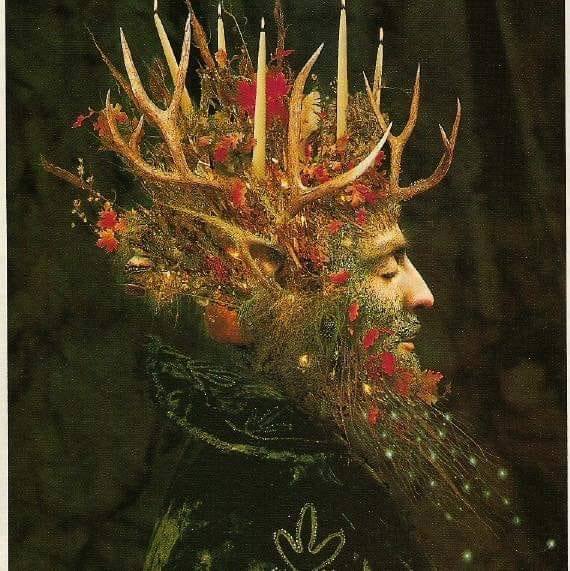
To which the Oak King replies,
Not hard to answer!
I am Hafgan, Lord of the Waxing Year,
I am the King of Oak,
I bring bud to leaf,
I Bring life to the Earth,
I banish the cold of Winter,
And welcome the warmth of Spring,
Brother, where do you come from
To which the Holly King replies,
Not hard to answer!
I come from Annwn, the Otherworld,
And at the time of your greatest power I am born into this world of Abred,
I ride on Rhiannon’s horse to claim my throne,
Laughing with the Wild Hunt I ride through the night sky,
My cold breath makes way for the coming of the Cailleach,
And the land is bathed in the beauty of ice and darkness,
Whilst Annwn blossoms, in your heat,
So Abred has peace, reflection, and renewal,
Guarded by Orion of the Silver Belt.
And you my brother, where do you come from?
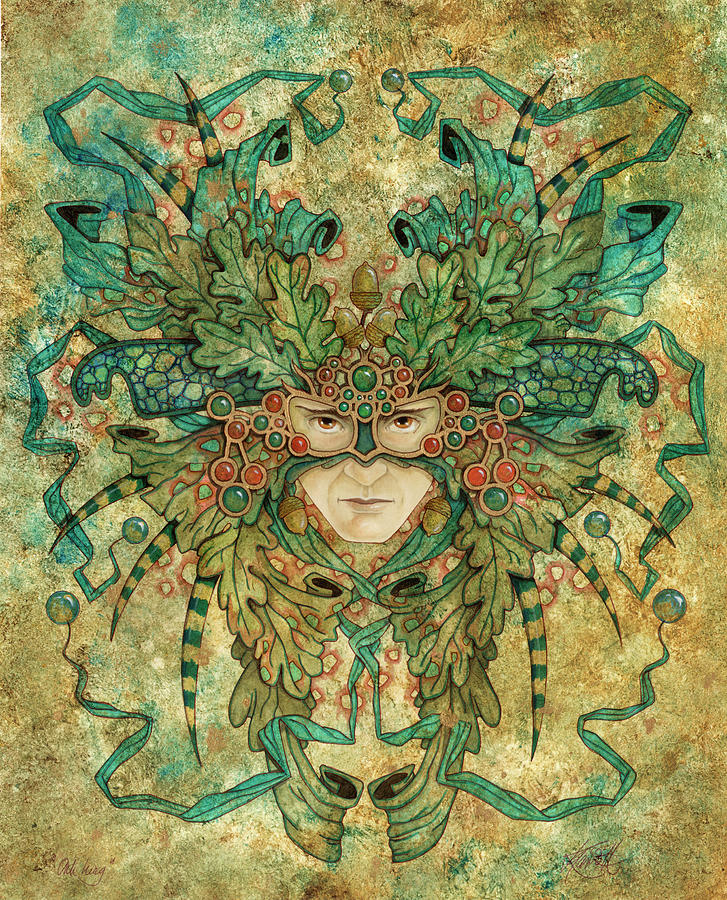
To which the Oak King replies,
Not hard to answer!
I come from Annwn, the Otherworld.
And at the time of your greatest power I am born into this world of Abred,
Called by the singing of the Birds of Rhiannon,
The warmth of my breath, and my seed, awakens the life within my Queen,
And the land is bathed in the beauty of our love,
Whilst Annwn is ruled by Winter and Ice,
So Abred blossoms, caressed by the heat of my gazing eye.
Brother, What art do you perform?
To which the Holly King replies,
Not hard to answer!
I give space to thought,
Bring renewal from death,
Bring rest to life, and transformation to your crown of green,
I light the inner fire, and the hearth,
And quicken the heart of the beast,
My Bards are the stillness of the winter sky,
The reflection on the water,
The tears of the ice,
Life returns to that space where dreams are forgathered,
Lovers lie before the flickering fires in their homes,
And new life is nourished as my Lady strips bare the branches,
And lays her cloak of white across the land.
And you, my brother, what art do you perform?
To which the Oak King replies,
Not hard to answer!
I lift the saddened heart,
Bring life to death,
Shape the hidden green,
Give flight to birds and insects,
My Bards sing upon their wing,
My orchestra plays music within the land,
Life returns, and in that space where thought becomes dream,
Lovers walk upon the warm earth,
And lay under the stars, and the Sun, together.
And I am here my Brother, to take my crown.
The Holly King places the crown on the Oak King’s head, and says
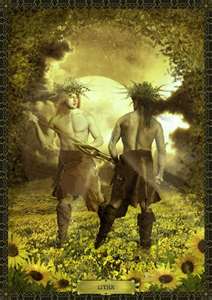
Then take this crown, but know this –
Even though you begin your rule,
My frost will form,
My touch will turn leaf to earth
Turn the fields to hardened mud,
And I will cool the oceans.
For although you take the power of light.
I retain the power of winter,
Until your Lady joins you,
At Beltane.
By Damh the Bard
CELEBRATION OF WINTER SOLSTICE AND YULE: A RITUAL
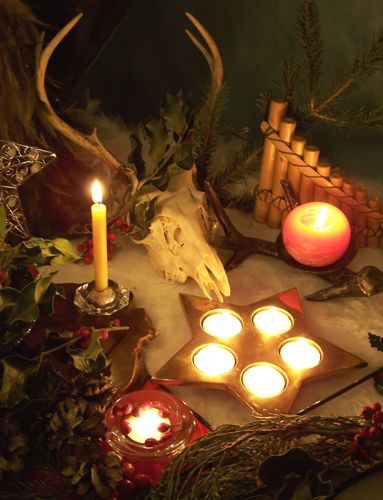
Cycles occur in more than the world around us. It’s so easy to forget, with all our technology, all our bread and circuses, that we are a part of nature, not separate from it. And like the trees and animals, we need time to rest and nurture ourselves for the next growing season. We, too, grow weary after a long summer. We tire and fade and need to go into darkness for a time. We renew there, heal the wounds and tend the fire within. ~Irene Glasse
Ritual for Winter Solstice
Welcome and Introduction
This is the time of the Winter Solstice – the longest night of the year. And though darkness triumphs, yet soon it shall give way before the light. All nature is hushed – all wait, as within the womb of night, darkness is transformed into light. Solstice is a time of pause: so, pause, breathe, relax and be at peace as we watch for the coming of dawn, when the day shall again give birth to the sun, the bringer of the promise of Spring. We are here tonight to turn the wheel of the year, thus, to call the light. Therefore, we call the sun from the womb of the night!
All gather outside. Everyone carries a lighted candle(votive), which they light from the Peace Candle as they enter. The candle is to be placed on the large tray on the on the altar, as we sing the following chant to the sound of the drum.
All sing:
Deep, Deep, Deep.
Into the heart of the winter
Deep, deep, deep,
Into the womb of the Mother
Deep, deep, deep
Where there is no other
Song but the song of my soul.
Invocation
Spirit of winter rest, help us to enjoy your peace in this sacred space
Remind us to pause during this season.
Grant us awareness, keep our gratitude fresh each day
May the songs in our hearts bring blessings and insights to ourselves and others May compassion always shine forth from the depths of our hearts.
(Pause)Everyone be seated.
Purification with the elements
Purification with the Elements (in lieu of calling) with accompaniment of zills and drums: Each purifier goes to the altar and takes the symbol of their element. They raise the symbol, lower it, then move to, and honor the next direction in the same fashion. They then circle around the altar, presenting the element to each direction in the same way. Upon reaching their original position, they honor their direction once more, then return the element to its place on the altar. This action is choreographed to the rhythm of the drum and finger cymbals.
All chant with the drum:
We are a circle
Within a circle
With no beginning
And never ending
Reflections on the seasons
Its not snowing outside, and we are not in the bleak midwinter. Nor are we living on a pre-Christian English farm. We are in California, in the twenty first century, in December, and we barely need coats. But we can still feel the season. The nights are longer and there is a chill in the air at night. Not all, but many trees have dropped their leaves, and although they didn't put on the fiery show of a New England tree, they speak to us, still, with their naked branches.
We can find the spirit of Yule, but for that we must mostly go within ourselves. There is a definite difference between Summer and Winter Solstice. It is in the difference that we connect to Yule. The two solstices are as different as the Holly and the Oak King. We have our mythology, where we find the lessons for the changes in the spiraling year. Let us enjoy a Solstice story, and listen for what resonates with you at this time of year.
Colloquy Of the Holly and the Oak king as a Meditation:
To better picture this word-play, I ask that you get comfortable in your seats, take a few deep breaths, and close your eyes. Picture yourself sitting on the ground within the pitch dark central room of the New-grange Passage Tomb. It is cold, but an air of expectancy is in the air. You are waiting, waiting for the first rays of the Winter Solstice Sun.
For It is said at the time of the solstices, two great kings do battle, The Oak king who rules the waxing year and the Holly King who who rules the waning year. This is not a battle of hate, but rather is a battle of light and reflects the arc of the sun as it makes its journey across our skies. Some say that the battle is won and lost by the power of the sword, but here, the Oak and Holly King enter a colloquy, an ancient bardic battle of words and wit to win the crown, and the light of the land.
Cold and bright the solstice dawn breaks through the doorway of the passage graves
Time out of mind the stones have stood marking the nadir of the sun’s journey across the sky.
Placed by our ancient hands, with stone on stone they were shaped and pulled from the earth’s embrace,
With magic they were raised upon our sacred land.
And at this time of the Solstice,
A figure waits within the tomb.
He waits in darkness, and in stillness,
He waits for the coming dawn,
The rising of the Sun,
And the footsteps of his brother.
The Oak king turns to greet the Holly King, and asks
Brother, what is your name?
To which the Holly King replies,
Not hard to answer!
I am Arawn, Lord of the Waning Year,
I am the King of Holly,
I strip bare the leaf-ridden trees,
I bring darkness to this land,……and peace,
I banish the warmth of Summer
And welcome the iciness of Winter.
And you my brother, what is your name?
To which the Oak King replies,
Not hard to answer!
I am Hafgan, Lord of the Waxing Year,
I am the King of Oak,
I bring bud to leaf,
I Bring life to the Earth,
I banish the cold of Winter,
And welcome the warmth of Spring,
Brother, where do you come from
To which the Holly King replies,
Not hard to answer!
I come from Annwn, the Otherworld,
And at the time of your greatest power I am born into this world of Abred,
I ride on Rhiannon’s horse to claim my throne,
Laughing with the Wild Hunt I ride through the night sky,
My cold breath makes way for the coming of the Cailleach,
And the land is bathed in the beauty of ice and darkness,
Whilst Annwn blossoms, in your heat,
So Abred has peace, reflection, and renewal,
Guarded by Orion of the Silver Belt.
And you my brother, where do you come from?
To which the Oak King replies,
Not hard to answer!
I come from Annwn, the Otherworld.
And at the time of your greatest power I am born into this world of Abred,
Called by the singing of the Birds of Rhiannon,
The warmth of my breath, and my seed, awakens the life within my Queen,
And the land is bathed in the beauty of our love,
Whilst Annwn is ruled by Winter and Ice,
So Abred blossoms, caressed by the heat of my gazing eye.
Brother, What art do you perform?
To which the Holly King replies,
Not hard to answer!
I give space to thought,
Bring renewal from death,
Bring rest to life, and transformation to your crown of green,
I light the inner fire, and the hearth,
And quicken the heart of the beast,
My Bards are the stillness of the winter sky,
The reflection on the water,
The tears of the ice,
Life returns to that space where dreams are forgathered,
Lovers lie before the flickering fires in their homes,
And new life is nourished as my Lady strips bare the branches,
And lays her cloak of white across the land.
And you, my brother, what art do you perform?
To which the Oak King replies,
Not hard to answer!
I lift the saddened heart,
Bring life to death,
Shape the hidden green,
Give flight to birds and insects,
My Bards sing upon their wing,
My orchestra plays music within the land,
Life returns, and in that space where thought becomes dream,
Lovers walk upon the warm earth,
And lay under the stars, and the Sun, together.
And I am here my Brother, to take my crown.
The Holly King places the crown on the Oak King’s head, and says
Then take this crown, but know this –
Even though you begin your rule,
My frost will form,
My touch will turn leaf to earth
Turn the fields to hardened mud,
And I will cool the oceans.
For although you take the power of light.
I retain the power of winter,
Until your Lady joins you,
At Beltane.
Bringing in theYule Log —gong/drum roll
Oak King: (Loudly) Bring in the Yule Log! raise the mistletoe and Holly!
Yule Log, holly and mistletoe are brought in. Holly & mistletoe are hung in the two curtained entrances. Then theYule King speaks:
Yule king: O Great fire - The magic now begins
Yule Log is lighted by Maggie wearing the sun mask while we sing
Everyone Sing:
Deck the Halls
Deck the halls with boughs of holly,
Fa la la la la la la la la.
‘Tis the season to be jolly,
Fa la la la la la la la la.
Don we now our gay apparel
Fa la la la la la la la la.
Troll the ancient Yuletide carol,
Fa la la la la la la la la.
See the blazing yule before us,
Fa la la la la la la la la.
Strike the harp and join the chorus.
Fa la la la la la la la la.
Follow me in merry measure,
Fa la la la la la la la la.
While I tell of Yuletide treasure,
Fa la la la la la la la la.
Fast away the old year passes,
Fa la la la la la la la la.
Hail the new, ye lads and lasses!
Fa la la la la la la la la.
Sing we joyous all together,
Fa la la la la la la la la.
Heedless of the wind and weather,
Fa la la la la la la la la.
Oak King: Bring in the Feasting Tables!
Altar is moved, and feasting tables are brought in. After tables are brought in, everyone gets their food and places it on their table. The food is blessed.
Blessings of the Feast
Blessed are all who gather here
Blessed is the bounty we share
Blessed are those who are not here to
share it
Nourished are we by this feast
Nourished are we by each other
Oak King (starts feasting with a toast)
Through scented smoke and sacred prayer we manifest goodwill
Bring peace and joy to hearth and home, and every wish fulfill.”
Feasting within the circle:
Benediction:
On this night so long,
keep me in your loving care.
I await the sunrise
And the Sun King who will bear
Light and Warmth and Love,
As he has in years before.
So guide me to the dawn.
This Solstice Night and ever more. Blessed Be!
Getting Creative: The Holly and The Oak King Art Project
One way to really experience the story of the Holly and the Oak King is to make your own. As you add leaves and berries your can meditate on who each king is and how they take on the crown of the season. This is easy to do if you start with a Santa figure and then make him new clothes and robes. This helps you to look for the contrast between the two kings and their seasons.
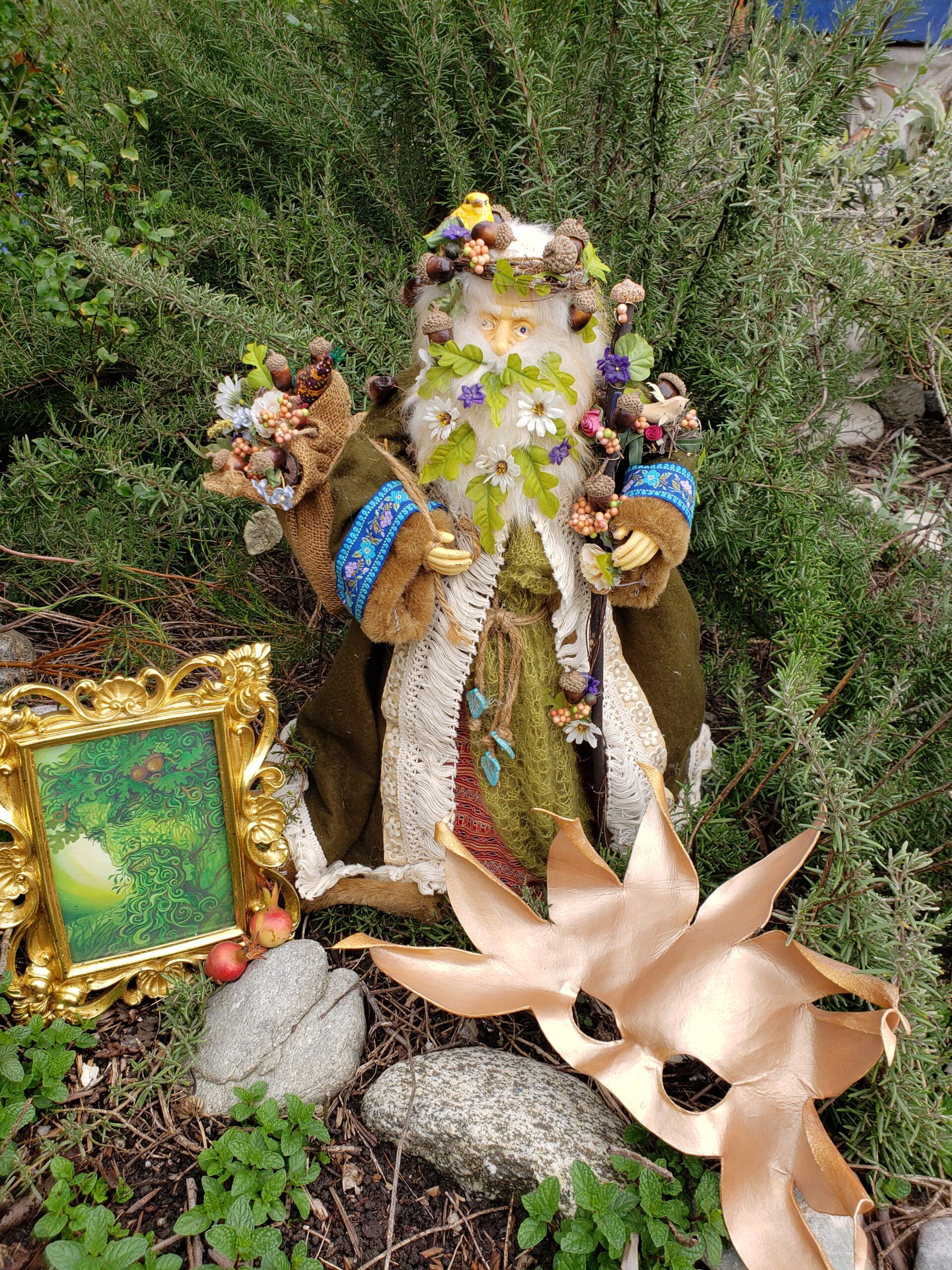
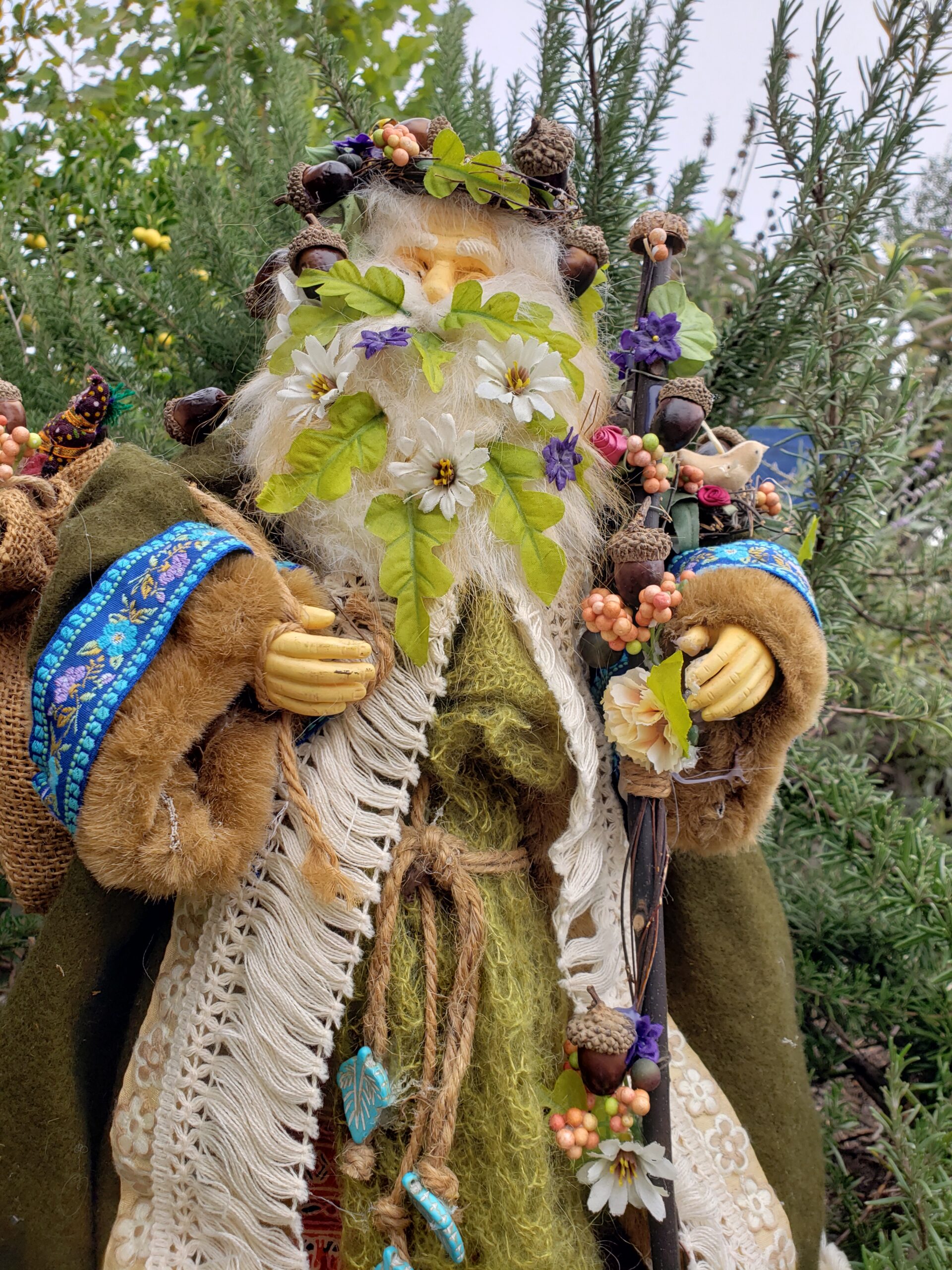
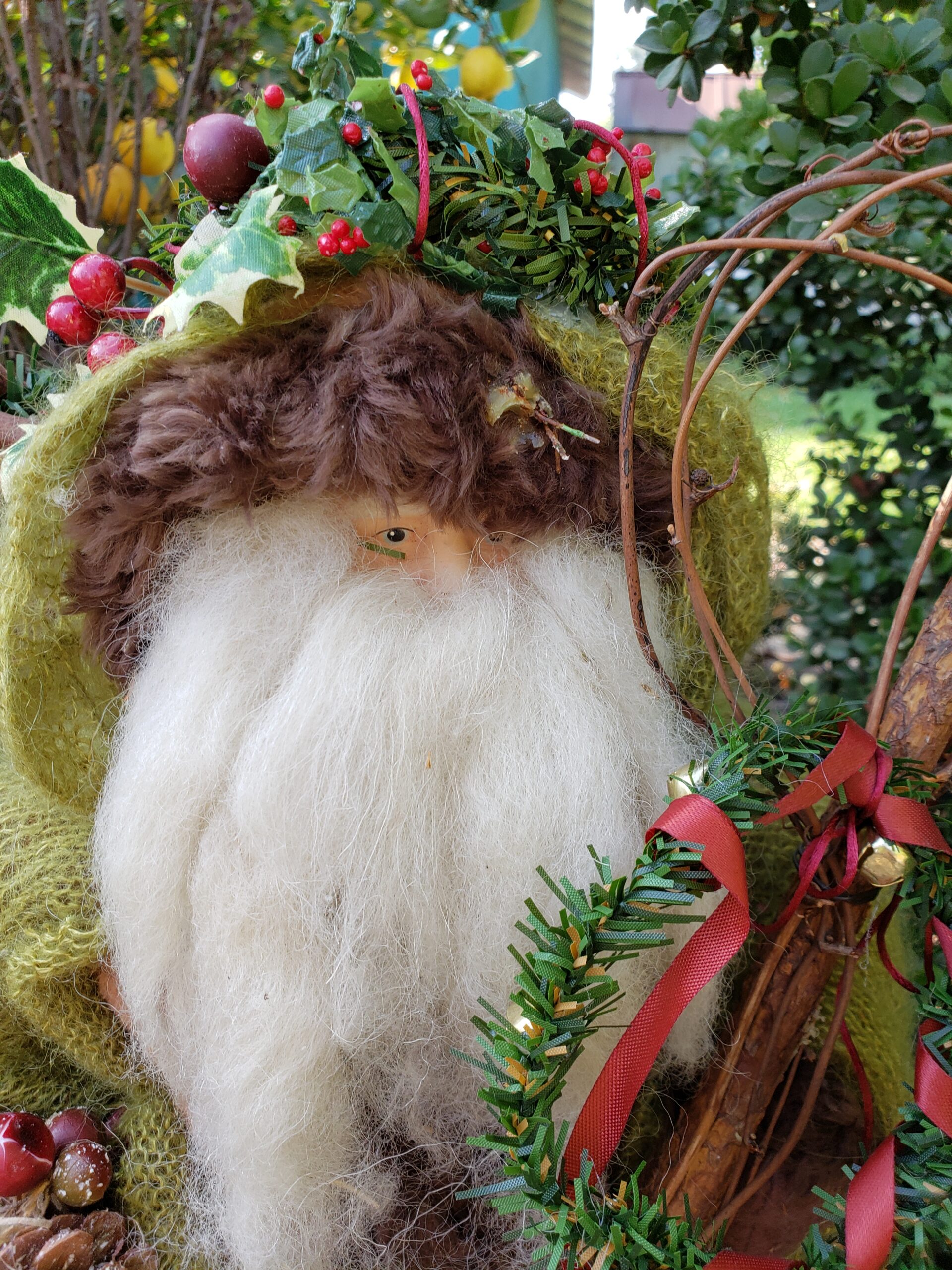
Holly King
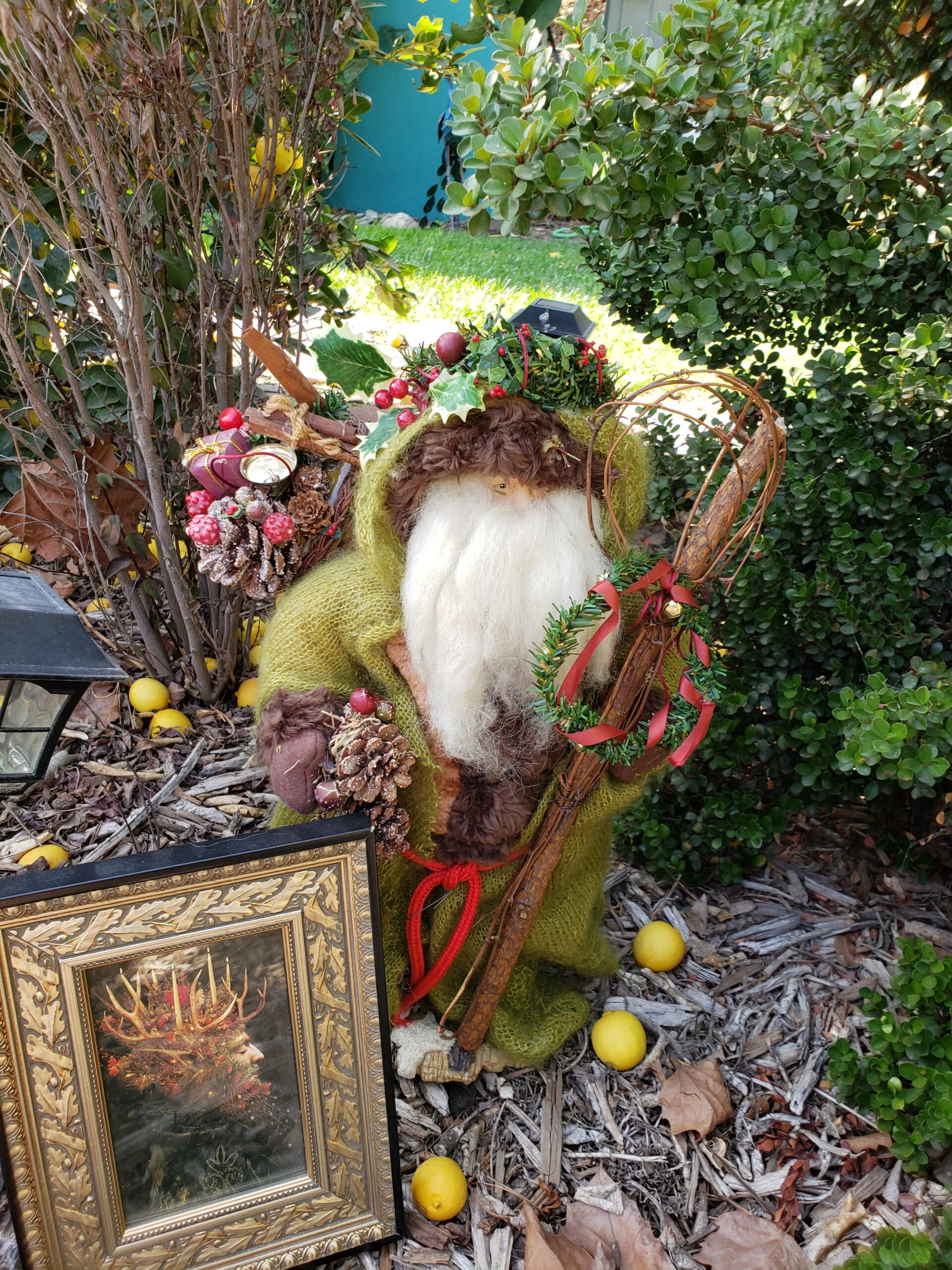
Holly King
Misletoe
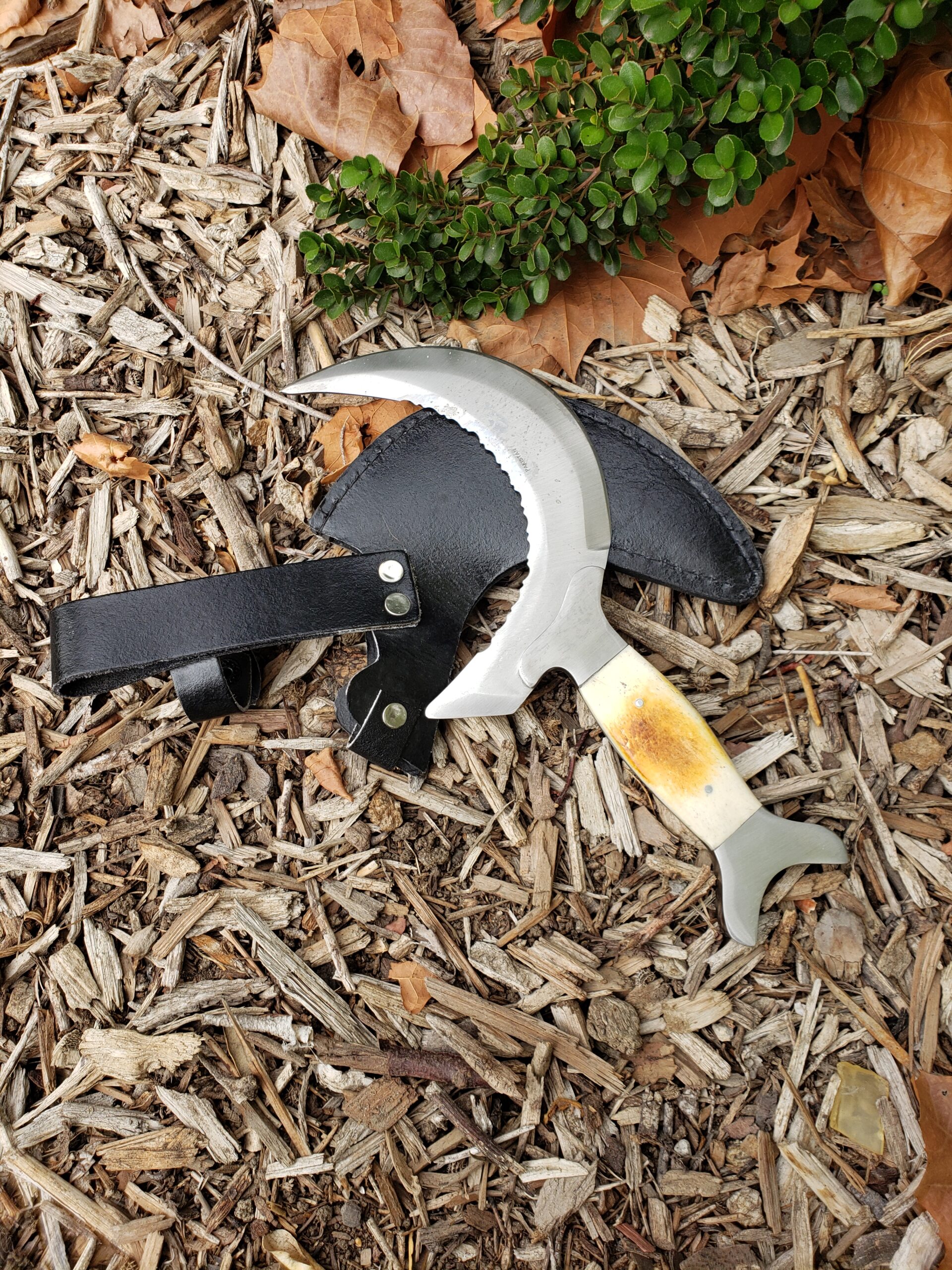
Druid Sickle for cutting Mistletoe
Mistletoe is a parasitic plant that grows in the branches of trees
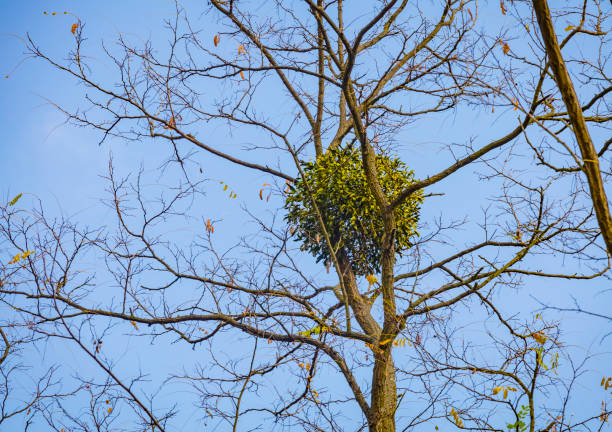
Ancient Druidry
According to Pliny the Elder, the druidic priesthood valued, worshipped even, mistletoe where it grew on their sacred trees, particularly their oaks (on which European mistletoe is, actually, very rare). They would climb the tree to harvest it, cutting it with a golden sickle, then let it fall naturally to be caught in a hide or cloak before it touched the ground. If it did reach the ground it would lose its special powers. The special harvest would then be used in ritual or in medicine.
Mari Lwyd
Midnight. Midnight. Midnight. Midnight. Hark at the hands of the clock. Now dead men rise in the frost of the stars And fists on the coffins knock. They dropped in their graves without one sound; 5 Then they were steady and stiff. But now they tear through the frost of the ground As heretic, drunkard and thief.
Traditions always tie us to our ancestors. They are prehensions that are held within the cauldron of being, but traditions change over time. We can't help adding new ingredients into the cauldron. That is where creativity comes in. The Mari Lwyd is having a revival as pagans discover her. She should be remembered for where she came from but also get some shinny new ribbons.
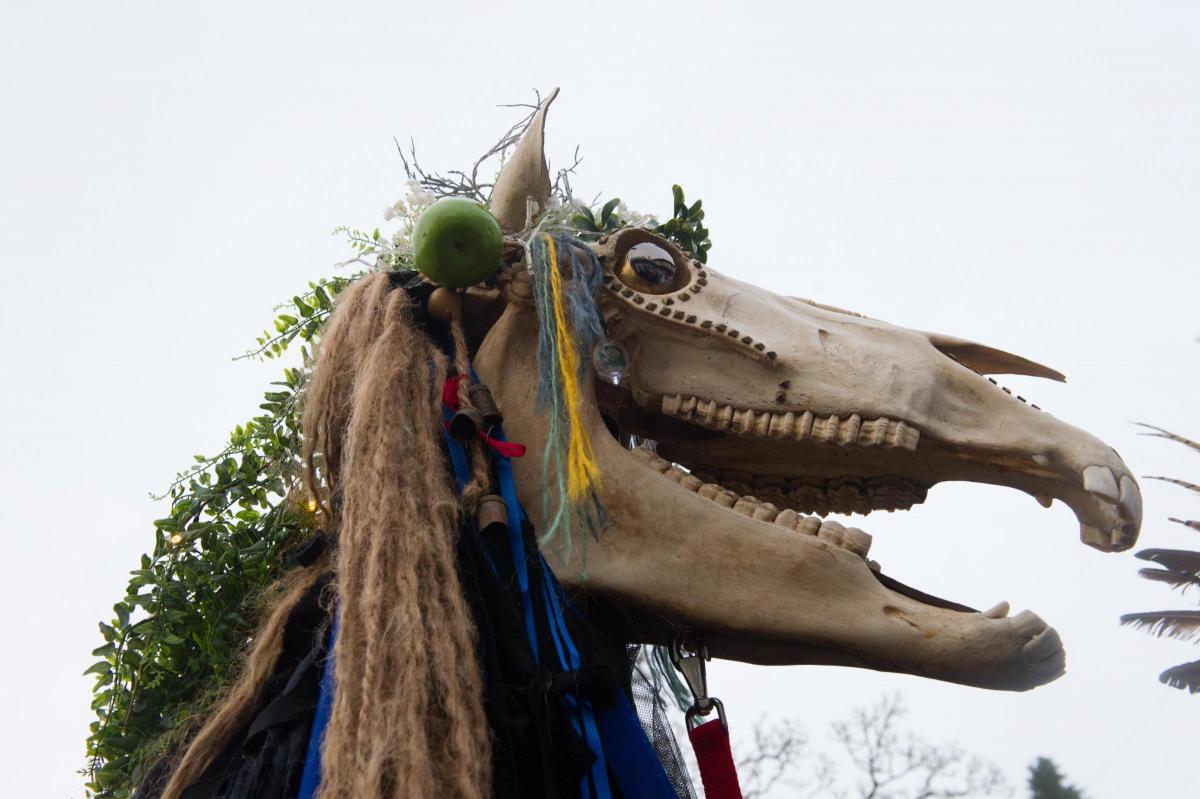
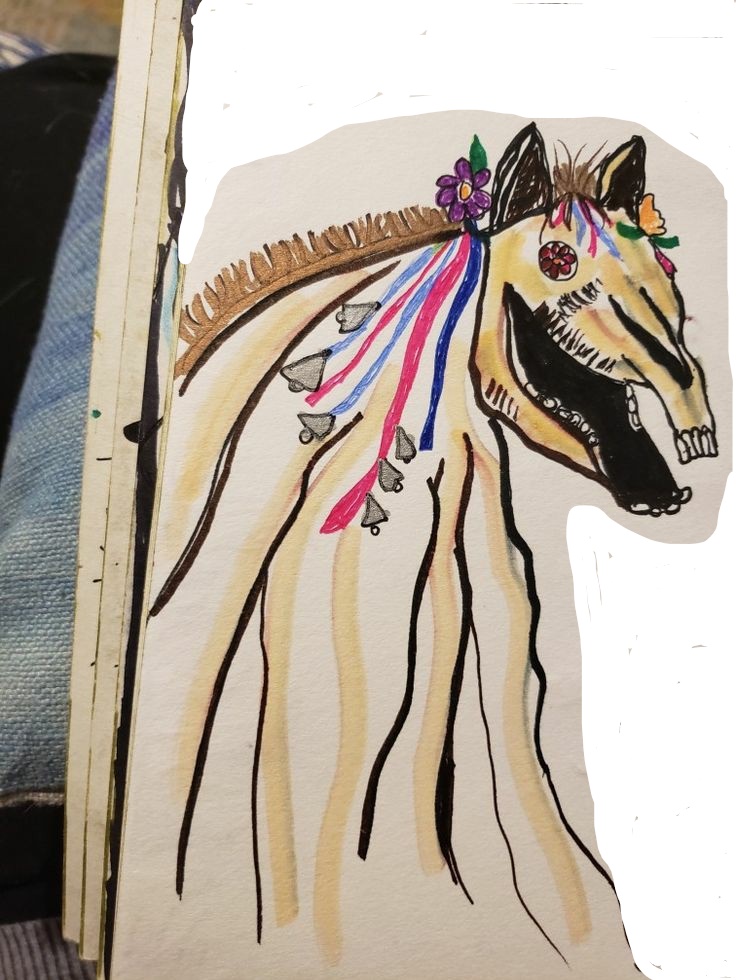
The Mari Lwyd itself consists of a horse's skull that is decorated with ribbons and affixed to a pole; to the back of the skull is attached a white sheet, which drapes down to conceal both the pole and the individual carrying this device. In some instances, the horse's jaw was able to open and close as a result of string or lever attached, allowing the Mari to sing. There are accounts of pieces of glass being affixed into the eye sockets of some examples, representing eyes.
The Mari Lwyd party would approach a house and sing a song in which they requested admittance. The inhabitants of the house would then offer excuses for why the team could not enter. The party would sing a second verse, and the debate between the two sides – known as the pwnco (a form of musical battle) – would continue until the house's inhabitants ran out of ideas, at which time they were obliged to allow the party entry and to provide them with ale and food
Wel dyma ni’n dwad (Well here we come)
Gy-feillion di-niwad (Innocent friends)
I ofyn am gennad (To ask leave)
I ofyn am gennad (To ask leave)
I ofyn am gennad i ganu (To ask leave to sing)
At the end of the day, the point isn’t really to send Mari Lwyd packing. Her visit is meant to bring luck to your household during the year ahead, and besides, she’s an undead horse who’s been rhyming since the pre-Christian era—realistically, you won’t outsmart her. When you’re ready to concede, William Butler Yeats’s “A Drinking Song” will do, whether you’re sighing in romantic admiration or resigned defeat.
Wine comes in at the mouth
And love comes in at the eye;
That’s all we shall know for truth
Before we grow old and die.
I lift the glass to my mouth,
I look at you, and I sigh. 1
A Modern Mari Ritual
The photos below are of a Mari Lwyd made by Kathleen Reeves using a Halloween mask and altering it to resemble a Mari. Real horse skulls can be obtained for $200 or more but it is difficult to ensure the ethical procurement of these skulls. Cardboard or papier-mâché skulls can be made instead.
Lament of the Mari Lwyd: The Mari Lwyd
In the darkest months of the Welsh year, a white horse appears: the mysterious, menacing Mari Lwyd. The origins of Mari’s name are, like the horse herself, are deeply mysterious. One Welsh translation of it, Grey Mare, connects it to the heritage of pale horses in Celtic and British mythology, many of whom can cross over to the underworld (Rhiannon in the Mabinogion rode a white horse, for example).
In modern times, her story has faded due to the spread of Christianity. Some pagans have linked her to the new mythology of the nativity story. A pregnant horse sent out of the stables when Mary arrived to have Jesus, she spent dark days roaming the land trying to find somewhere new to have a foal. Tonight, we will hear from the Mari herself.
The Cailleach/crone begins:
Midnight. Midnight. Midnight. Midnight.
Hark at the hands of the clock.
Now dead men rise in the frost of the stars
And fists on the coffins knock.
They dropped in their graves without one sound;
Then they were steady and stiff.
But now they tear through the frost of the ground
As heretic, drunkard and thief.
This time of year, she wakes,
Her lonely walk she takes
(Mari: far away voice ) Remember me? Let me in! let me in!
The Mari Lwyd, the horse of white
They only see a horse of fright
(Mari)Remember me? Let me in! let me in!
Her voice echos through time, remember me?
I’m Mari Lwyd, the winter mare, look and you will see
(Mari)Remember me? Let me in! let me in!
But she is turned away. The times have changed
The pagan ways have been replaced
(Mari)Remember me? Let me in! let me in!
and she has been driven away
Let her in, and honor the pagan ways
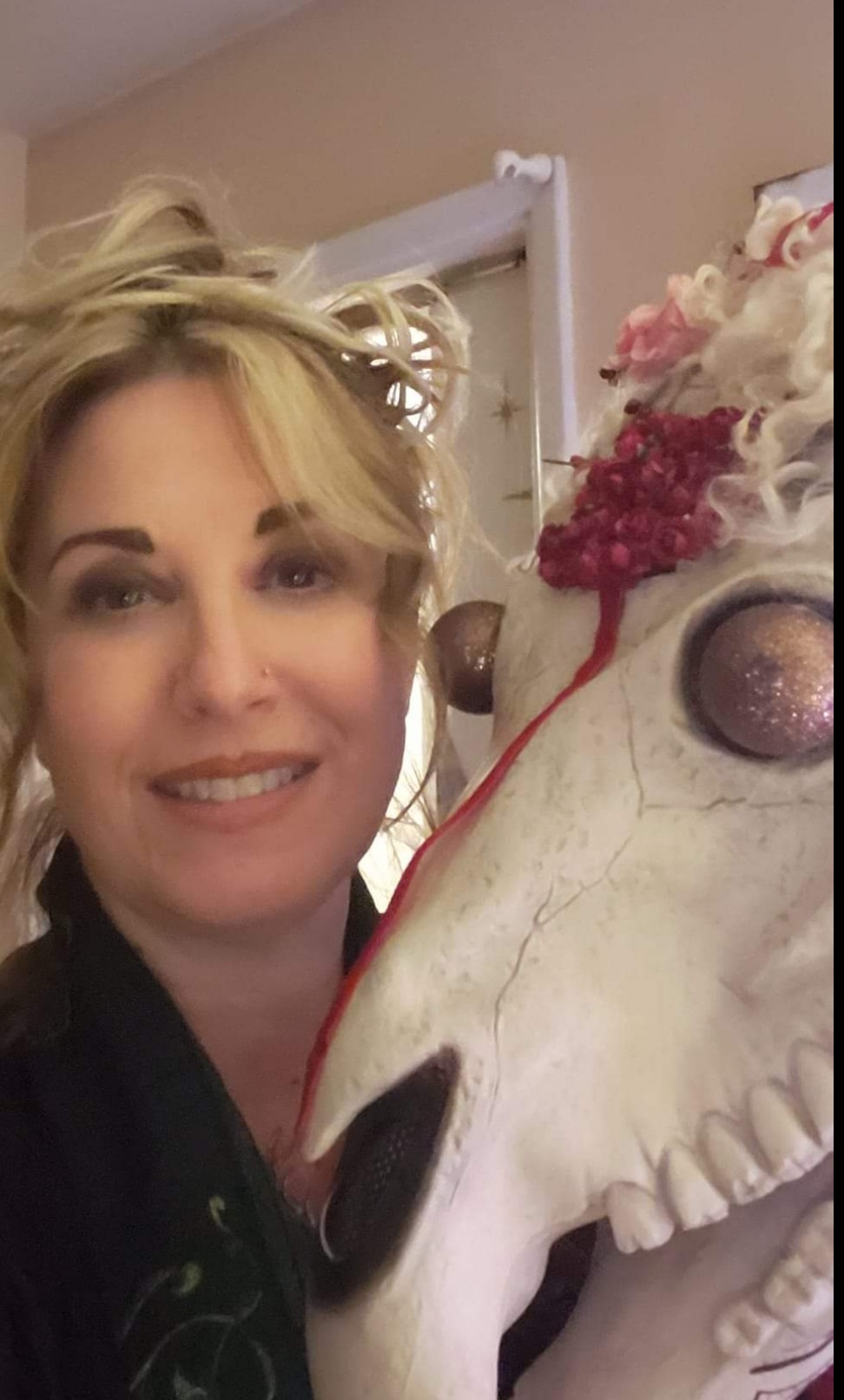

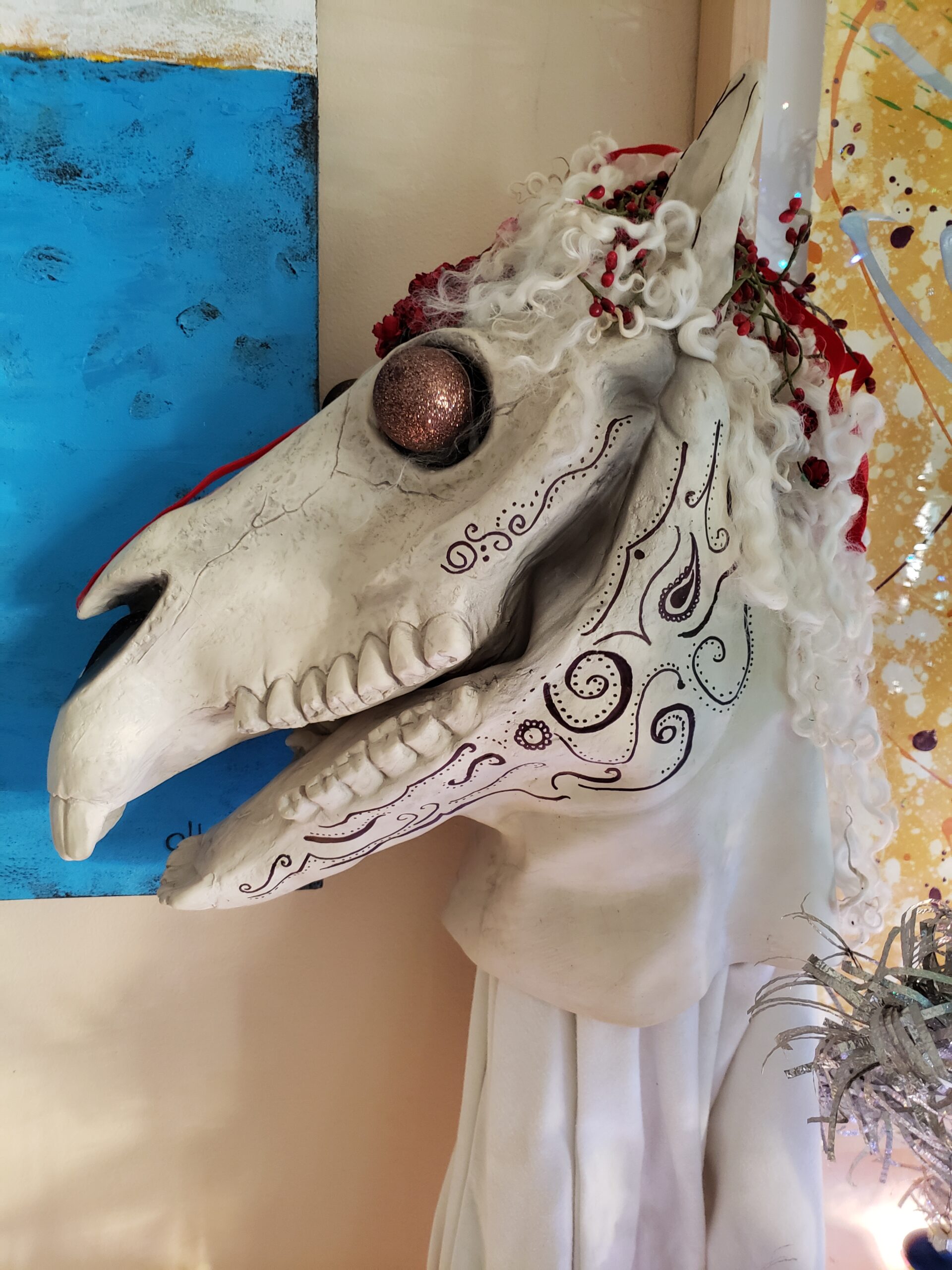
Mari to the east
The Hodening hoss,
The marbury dun,
Old Bone-face the deathless am I,
Heavy with Foal
Two thousand years
Bridled with sorrow,
Saddled with fear,
I canter through pastures
Of tremble and quake,
I gallop the track
Between sleep and awake
Seeking the deep of welcome
and stint for my tears
Let me in!
East:
Midnight. Midnight. Midnight. Midnight.
Hark at the hands of the clock.
Now dead men rise in the frost of the stars
And fists on the coffins knock.
No no, you frightening horse! no you may not come
We don’t know you, now go away to the dark where you come from
Mari to the South
The mare-headedd queen
The Mari-Lwyd
I was mother of all the herds
Ten thousand years my shining foals
Bridled with starlight
Saddled with gold
Leapt the divide
Between living and dead
Quickened the year
With each toss of the head
Galloped the deep of beauty
And never grew old
Let me in!
South
Midnight. Midnight. Midnight. Midnight.
Hark at the hands of the clock.
Now dead men rise in the frost of the stars
And fists on the coffins knock.
No no, you frightening horse! no you may not come
We don’t know you, now go away to the dark where you come from
Mari to the west
But Mother of God, The Mary Mild.
The pregnant Virgin came
Bursting with Jehovah seed
She entered my stable
And cried out her need
With ropes I was dragged
From the birthing straw
Aching with foal
I was heaved to the door
Swapping warmth for bitter weather
And birth of a rival creed
Let me in!
West
Midnight. Midnight. Midnight. Midnight.
Hark at the hands of the clock.
Now dead men rise in the frost of the stars
And fists on the coffins knock.
No no, you frightening horse! no you may not come
We don’t know you, now go away to the dark where you come from
Mari to the north
And now I am nightmare
I am rattling womb
The Uffington wraith I’ve become
Forced into darkness
You’ve made me a fiend
Bridled with shadow
Saddled with scream
From window to window
Traversing the night
My face in your glass
In a shudder of light
Seeking that deep of welcome
Befitting a Queen
Let me in once again
Let me in!
North
Midnight. Midnight. Midnight. Midnight.
Hark at the hands of the clock.
Now dead men rise in the frost of the stars
And fists on the coffins knock.
No no, you frightening horse! no you may not come
We don’t know you, now go away to the dark where you come from
Mari
A knock of the sands on the glass of the grave,
A knock on the sands of the shore,
A knock of the horse’s head of the wave,
A beggar’s knock on the door.
A knock of a moth on the pane of light,
In the beat of the blood a knock.
Midnight. Midnight. Midnight. Midnight.
Hark at the hands of the clock.
The sands in the glass, the shrinking sands,
And the picklock, picklock, picklock hands
Who will remember the old white mare
Who will let me in?
Who will let me in?
Who will let me in?
The Cailleach/crone
I will!
Mari turns to look at the crone and speaks:
Who remembers the old white mare
Who is the lady in black?
Who will pull me from the grave?
At the final tick of the clock?
Cailleach/crone:
The tide is turning
The Season is changing
Eyes are looking away
From the winter babe
was unable to save
and his bloody death
left such a mess
it’s time you returned to stay
Everyone Sing (while pouring a drink and libation):
Spiral is turning, Sing Season is changing, old one is waiting blessed is she
Cailleach/crone (starts feasting with a toast)
We are reconciled, we are reunited
What was wrong is now righted
We claim our traditions from the tomb of oblivion
And we have our own ways that will not be forgotten
Through scented smoke and sacred prayer we manifest goodwill
Bring peace and joy to hearth and home, and every wish fulfill.”
This ritual used a combination of a story by Hugh Lupton and a 1941 ballad by Vernon Watkins with additional rhymes by Kathleen Reeves. They are woven together to tell the story of the Mari Lwyd.
